CHEVROLET ASTRO 1996 Owners Manual
Manufacturer: CHEVROLET, Model Year: 1996, Model line: ASTRO, Model: CHEVROLET ASTRO 1996Pages: 372, PDF Size: 21.51 MB
Page 221 of 372
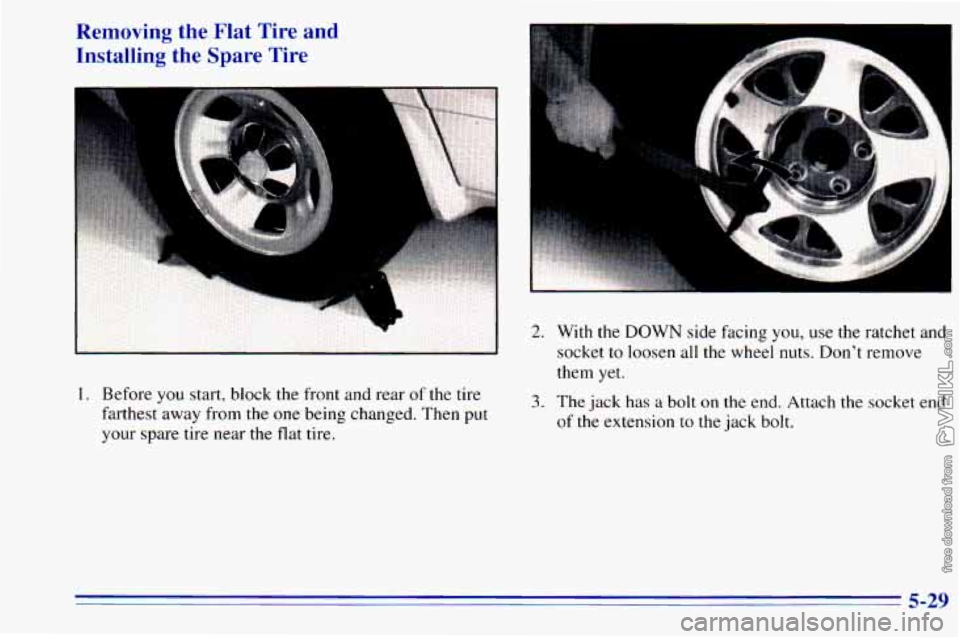
Removing the Flat Tire and
Installing the Spare Tire
-.
1. Before you start, block the front and rear of the tire
farthest away from the one being changed. Then put
your spare tire near
the flat tire.
F
2. With the DOWN side facing you, use the ratchet and
socket to loosen
all the wheel nuts. Don't remove
them
yet.
3. The jack has a bolt on the end. Attach the socket end
of the extension to the jack bolt.
5-29
Page 222 of 372
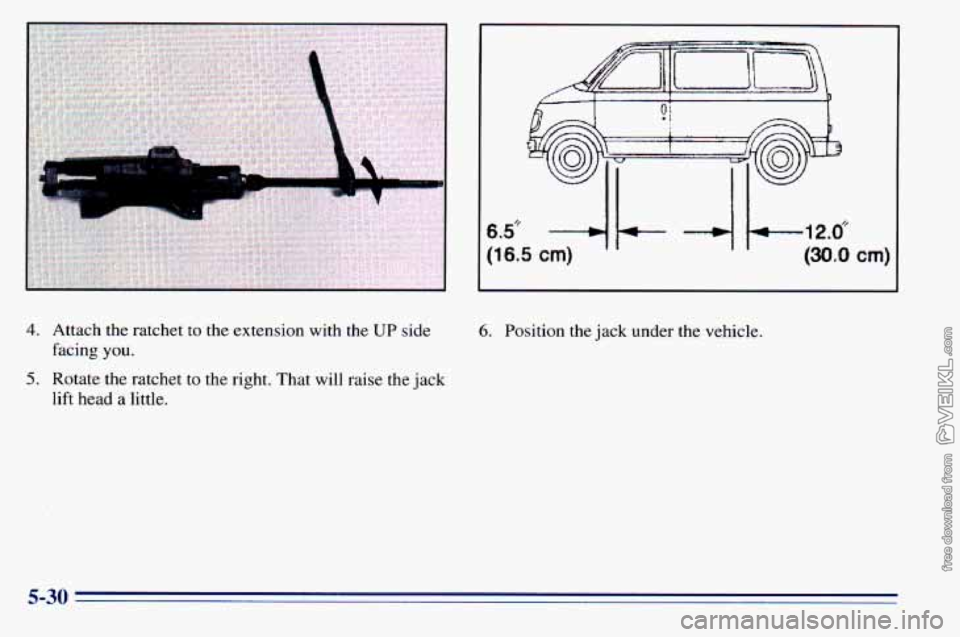
4. Attach the ratchet to the extension with the UP side
facing
you.
5. Rotate the ratchet to the right. That will raise the jack
lift head
a little.
6. Position the jack under the vehicle.
5-30
Page 223 of 372
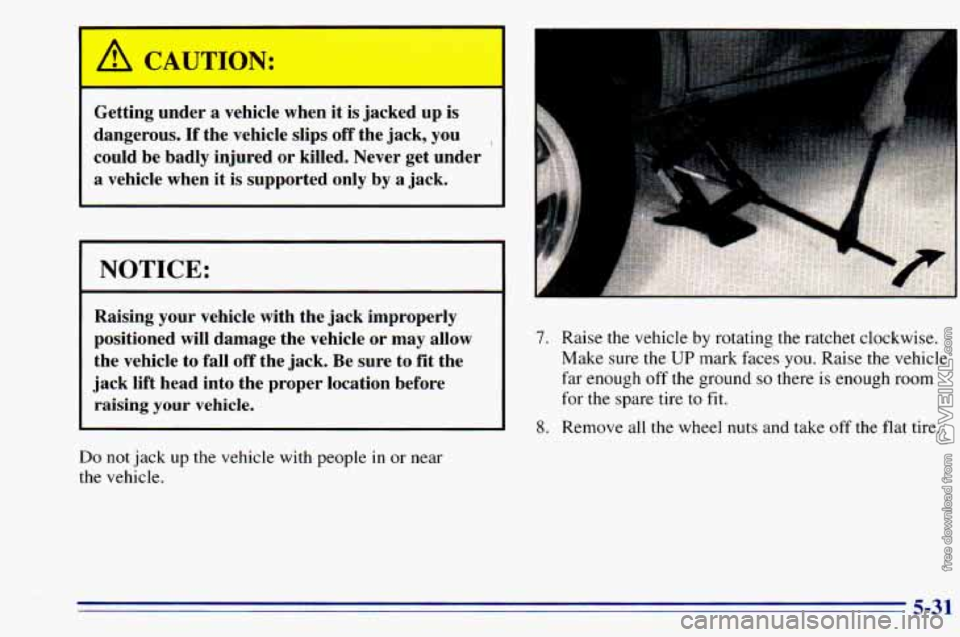
1
Getting under a vehicle when it is jacked up is
dangerous.
If the vehicle slips off the jack, you ~
could be badly injured or killed. Never get under
a vehicle when it
is supported only by a jack.
NOTICE:
Raising your vehicle with the jack improperly
positioned will damage the vehicle or may allow
the vehicle to fall
off the jack. Be sure to fit the
jack lift head into the proper location before
raising
your vehicle.
Do not jack up the vehicle with people in or near
the vehicle.
7. Raise the vehicle by rotating the ratchet clockwise.
Make sure the
UP mark faces you. Raise the vehicle
far enough off the ground
so there is enough room
for the spare tire to fit.
8. Remove all the wheel nuts and take off the flat tire.
5-31
Page 224 of 372
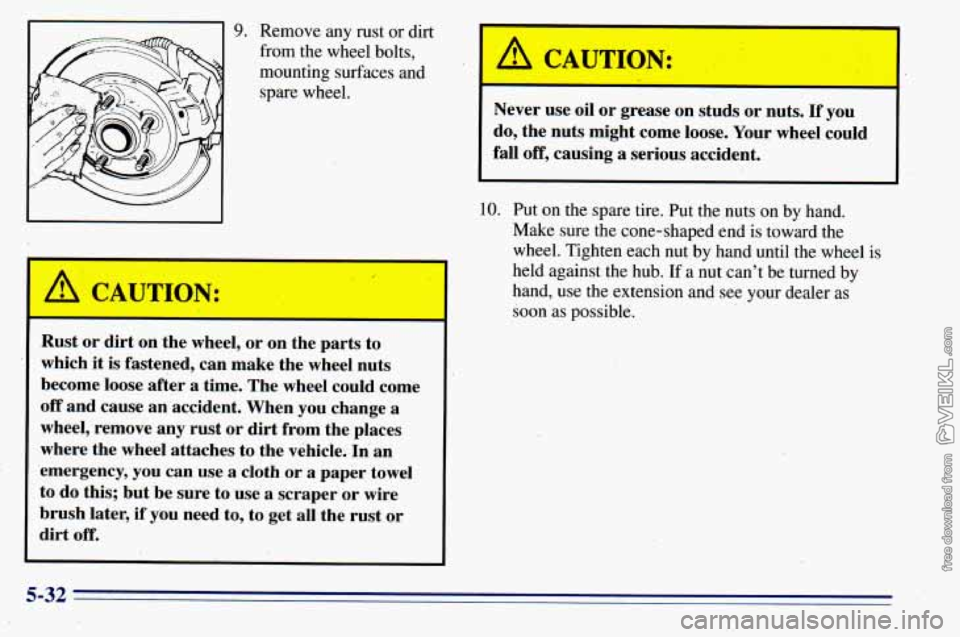
I I
9.
A CAUTION:
Remove any rust or dirt
from the wheel bolts,
mounting surfaces and
spare wheel.
-
Never use oil or grease on studs or nuts. If you
do, the nuts might come loose. Your wheel could
fall
off, causing a serious accident.
Rust or dirt on the wheel, or on tL parts to
which it is fastened, can make the wheel nuts
become loose after a time. The wheel could come
off and cause an accident. When you change a
wheel, remove any rust or dirt from the places
where the wheel attaches to the vehicle..In an
emergency, you can use a
cloth or a paper towel
to do this; but be sure to use a scraper or wire
brush later, if ybu need to, to get all the rust or
dirt
off.
10. Put on the spare tire. Put the nuts on by hand.
Make sure the cone-shaped end is toward the
wheel. Tighten each
nut by hand until the wheel is
held against the hub.
If a nut can’t be turned by
hand, use the extension and see your dealer as
soon as possible.
5-32
Page 225 of 372
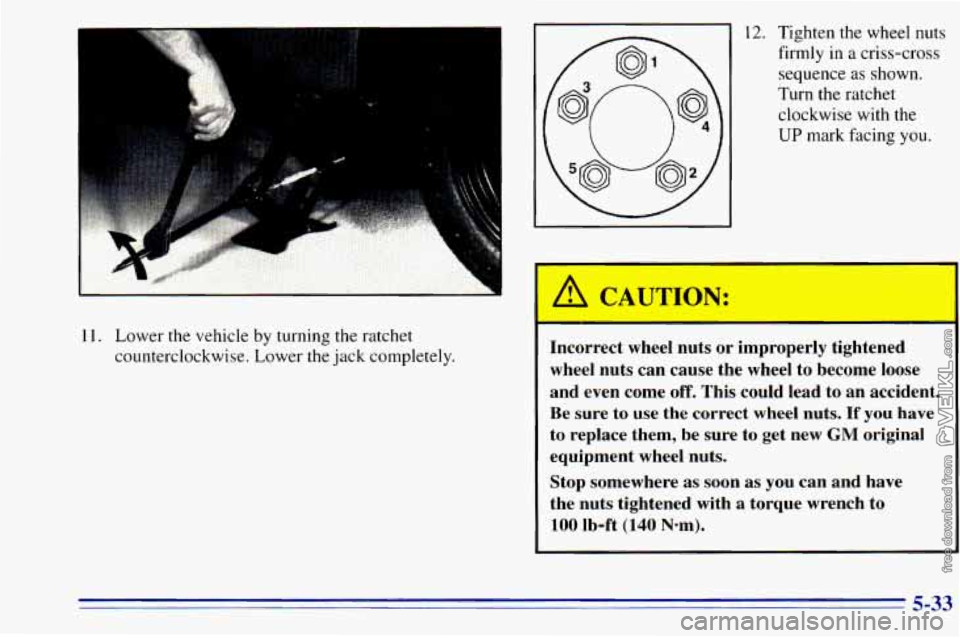
11. Lower the vehicle by turning the ratchet
counterclockwise. Lower
the jack completely.
12. Tighten the wheel nuts
firmly in a criss-cross
sequence as shown.
Turn the ratchet
clockwise with the
UP mark facing you.
A
11 CAUTION:
Incorrect wheel nuts or improperly tightened
wheel nuts can cause the wheel to become loose
and even come
off. This could lead to an accident.
Be sure to use the correct
wheel nuts. If you have
to replace them, be sure to get new
GM original
equipment wheel nuts.
Stop somewhere
as soon as you can and have
the nuts tightened with
a torque wrench to
100 Ib-ft (140 Nom).
I
5-33
Page 226 of 372
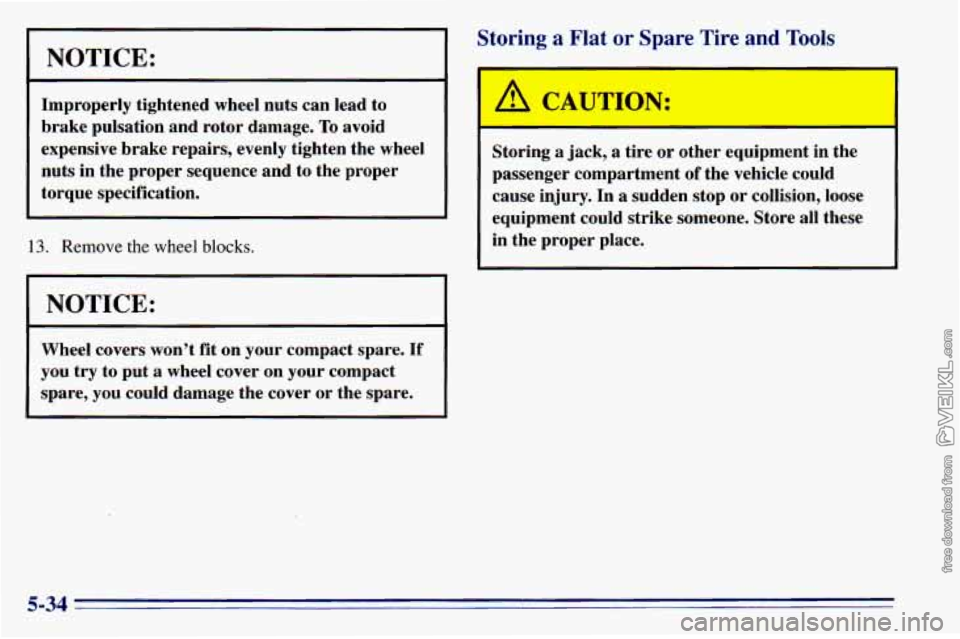
NOTICE:
Improperly tightened wheel nuts can lead to
brake pulsation and rotor damage.
To avoid
expensive brake repairs, evenly tighten the wheel
nuts in the proper sequence and to the proper
torque specification.
13. Remove the wheel blocks.
I NOTICE:
Wheel covers won't fit on your compact spare. If
you try to put a wheel cover on your compact
spare, you could damage the cover or the spare. Storing
a jack, a tire or other equipment in the
passenger compartment
of the vehicle could
cause injury. In a sudden stop or collision, loose
equipment could strike someone. Store all these
in the proper place.
5-34
Page 227 of 372
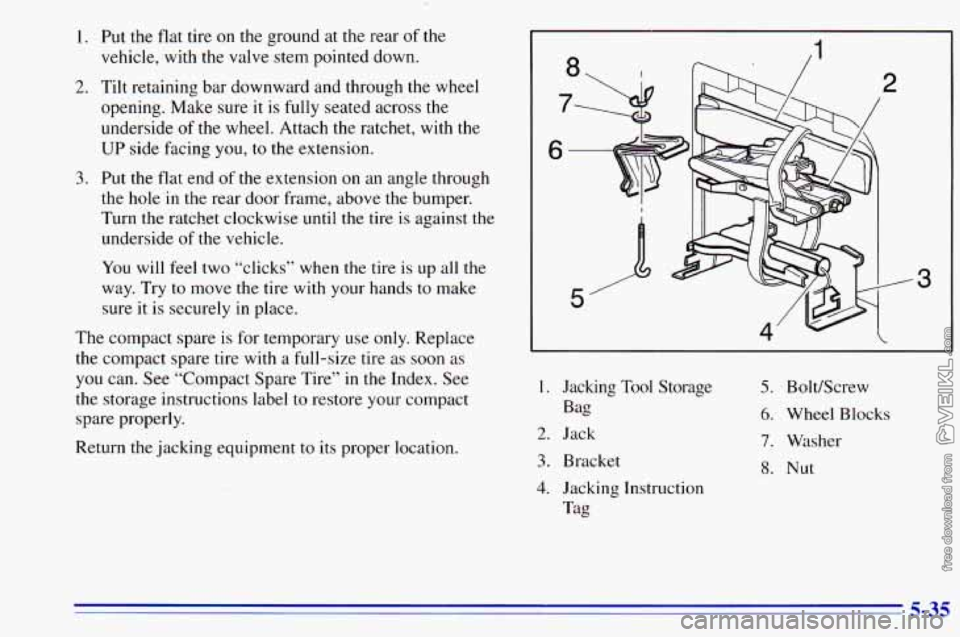
1.
2.
3.
Put the flat tire on the ground at the rear of the
vehicle, with the valve stem pointed down.
Tilt retaining bar downward and through the wheel
opening. Make sure it is fully seated across the
underside of the wheel. Attach the ratchet, with the
UP side facing you, to the extension.
Put the
flat end of the extension on an angle through
the hole in the rear door frame, above the bumper.
Turn the ratchet clockwise until the tire is against the
underside
of the vehicle.
You will
feel two “clicks” when the tire is up all the
way. Try to move the tire with your hands to make
sure it is securely in place.
The compact spare is for temporary use only. Replace
the compact spare tire with a full-size tire
as soon as
you can. See “Compact Spare Tire” in the Index. See
the storage instructions label to restore your compact
spare properly.
Return the jacking equipment
to its proper location.
I 4
3
I. Jacking Tool Storage
Bag
2. Jack
3. Bracket
4. Jacking Instruction
Tag
5. BoltKcrew
6. Wheel Blocks
7, Washer
8. Nut
5-35
Page 228 of 372
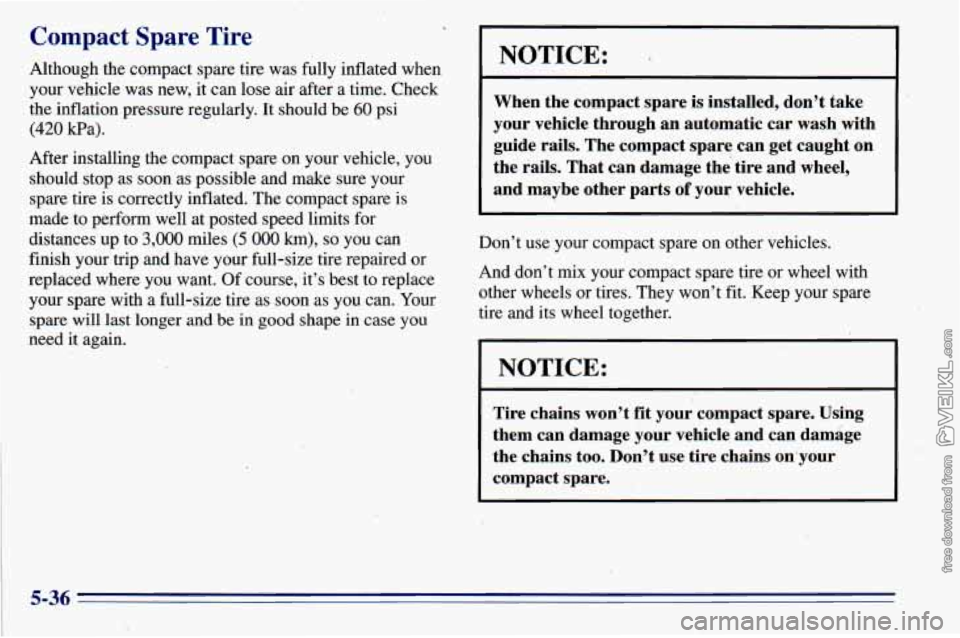
Compact Spare Tire
Although the compact spare tire was fully inflated when
your vehicle was new, it can lose air after a time. Check
the inflation pressure regularly. It should be
60 psi
(420 Wa).
After installing the compact spare on your vehicle, you
should stop as soon as possible and make sure your
spare tire
is correctly inflated. The compact spare is
made to perform well at posted speed limits for
distances up to
3,000 miles (5 000 km), so you can
fini.sh your trip and have your full-size tire repaired or
replaced where you want. Of course, it’s best to replace
your spare with a full-size tire as soon as you can. Your
spare will last longer and be in good shape in case
you
need it again.
NOTICE:
I
When the compact spare is installed, don’t take
your vehicle through an automatic car wash with
guide rails. The compact spare can get caught on
the rails. That can damage the tire and wheel,
and maybe other parts
of your vehicle.
Don’t use
your compact spare on other vehicles.
And don’t mix your compact spare tire or wheel with
other wheels or tires. They won’t fit. Keep your spare
tire and its wheel together.
NOTICE:
Tire chains won’t fit your compact spare. Using
them can damage your vehicle and can damage
the chains too. Don’t use tire chains on’your
compact spare.
5-36
Page 229 of 372
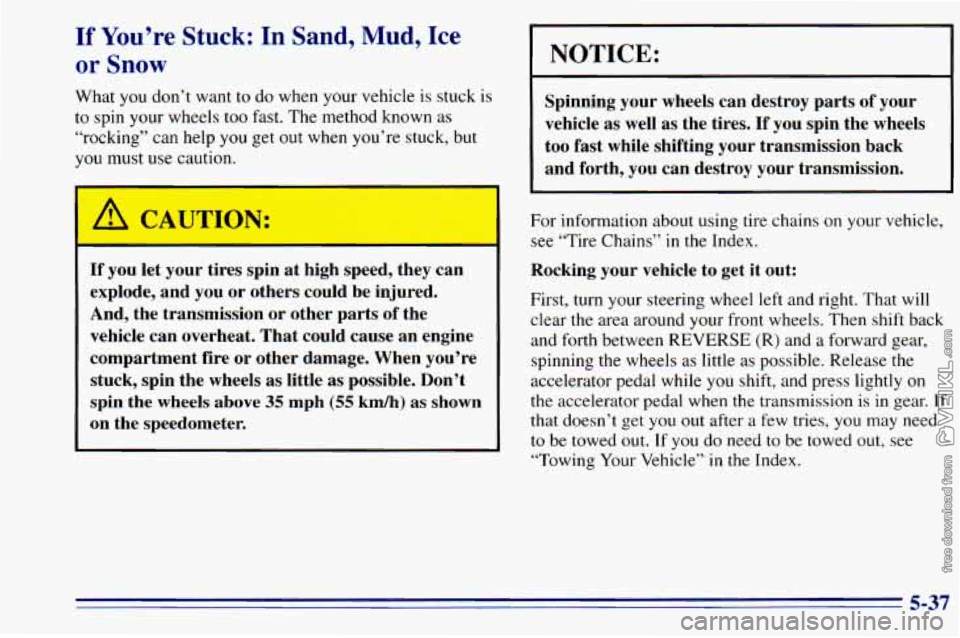
If You’re Stuck: In Sand, Mud, Ice
or Snow
What you don’t want to do when your vehicle is stuck is
to spin your wheels too fast. The method known as
“rocking” can help
you get out when you’re stuck, but
you must use caution.
A CAUTION:’
I
If you let your tires spin at high speed, they can
explode, and you or others could be injured.
And, the transmission or other parts of the
vehicle can overheat. That could cause an engine
compartment fire or other damage. When you’re
stuck, spin the wheels
as little as possible. Don’t
~ spin the wheels above 35 mph (55 km/h) as shown
~ on the speedometer.
I
NOTICE:
Spinning your wheels can destroy parts of your
vehicle
as well as the tires. If you spin the wheels
too fast while shifting your transmission back
and forth, you can destroy your transmission.
For information about using tire chains
on your vehicle,
see “Tire Chains” in
the Index.
Rocking your vehicle to get it out:
First, turn your steering wheel left and right. That will
clear the area around your front wheels. Then shift back
and forth between REVERSE
(R) and a forward gear,
spinning the wheels as little as possible. Release the
accelerator pedal while you shift, and press lightly
on
the accelerator pedal when the transmission is in gear. If
that doesn’t get
you out after a few tries, you may need
to be towed out. If you do need to be towed out, see
“Towing Your Vehicle’’’ in the Index.
5-37
Page 230 of 372
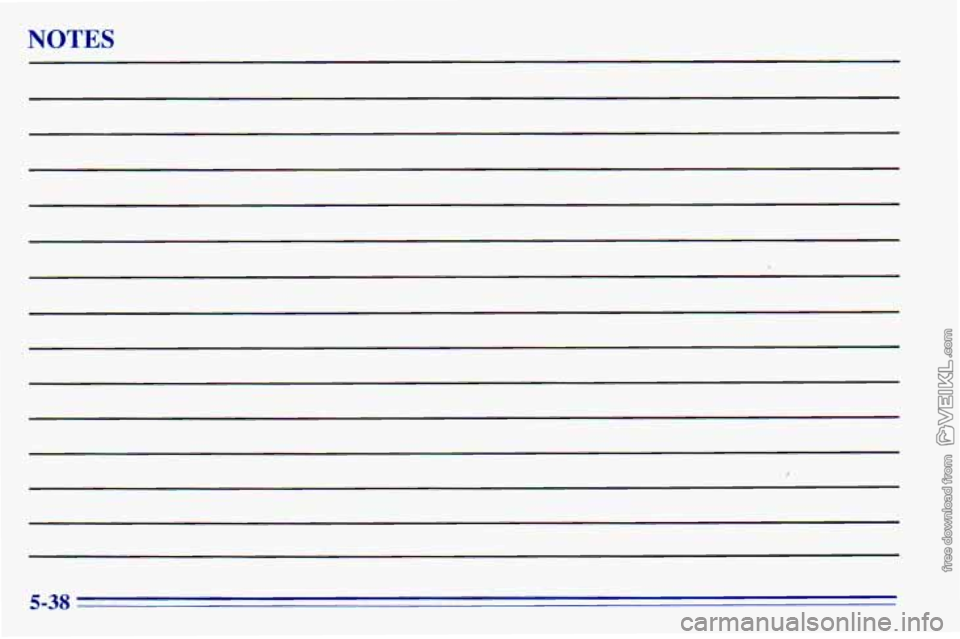
NOTES
5-38